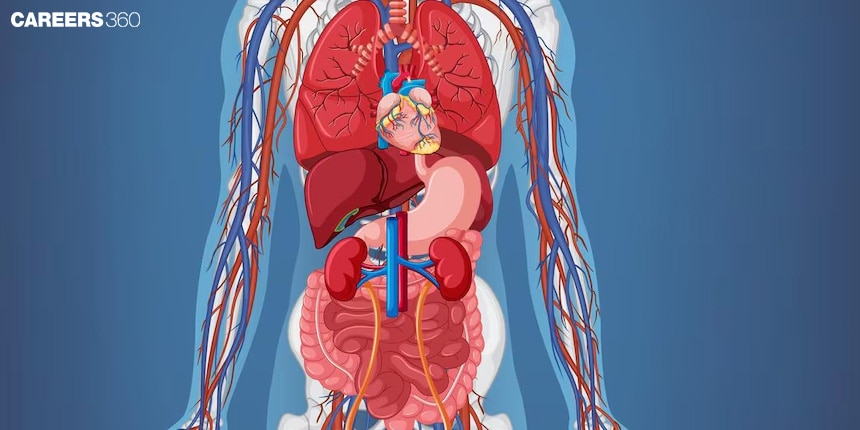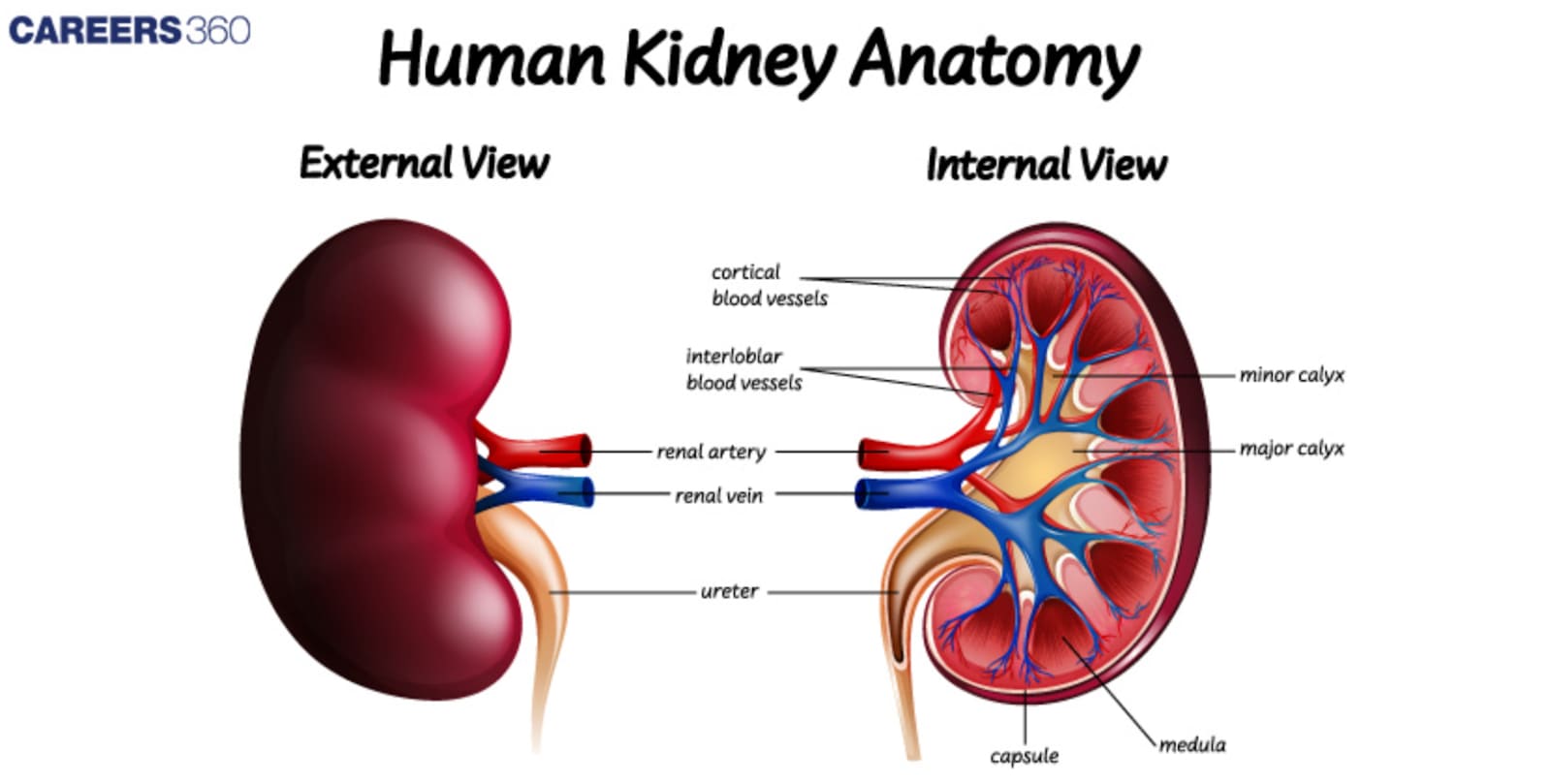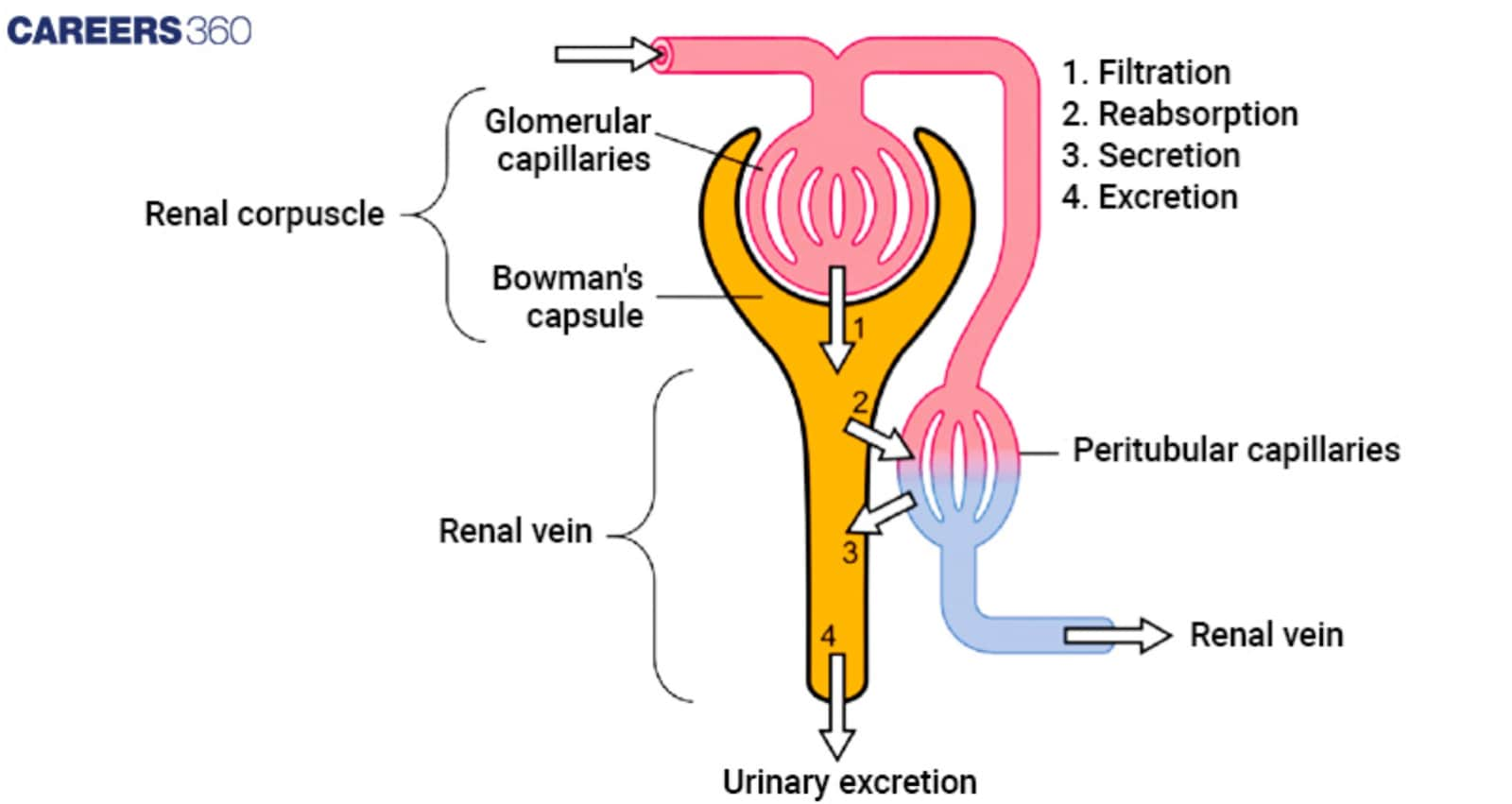Excretion: Definition, Function, Types, Examples
Excretion is the basic biological process through which living organisms eliminate the byproducts and wastes resulting from metabolism. Such byproducts include carbon dioxide, water, urea, and many others that metabolic processes produce. In humans and animals generally, there are specialized organs that filter and excrete the waste products. Thus, excretion is an important biological concept and is discussed in the Class 11 chapter Excretory Products and their Elimination in Biology.
NEET 2025: Mock Test Series | Syllabus | High Scoring Topics | PYQs
NEET Important PYQ's Subject wise: Physics | Chemistry | Biology
New: Meet Careers360 B.Tech/NEET Experts in your City | Book your Seat now
- What is Excretion?
- Types of Excretory Products
- Excretory Organs in Humans
- Mechanism of Urine Formation
- Common Disorders of the Excretory System
- Recommended Video for Excretion

What is Excretion?
Egestion is a process in which metabolic waste products of the organisms; for example, urea, and carbon dioxide are expelled from the body. It mainly affects kidneys works as filters for blood and gives urine as well as transitional tissue of the lungs eliminating carbon dioxide during the breathing process. It is required to be good for the regulation of the internal environment, fluids and electrolytes, pH and for excluding the toxic substances that may affect the body’s normal functions.
Types of Excretory Products
The different types of excretory products are:
Nitrogenous Wastes
Ammonia: It is a highly toxic compound for which the formation is the result of deamination of amino acids. The substance is soluble in water and therefore, it is mainly excreted through the gills in the case of aquatic animals.
Urea: Less toxic to tissues compared to ammonia and manufactured in the liver through the urea cycle. In mammals, amphibians, and some fish, it is eliminated from the body through the kidneys by being incorporated in urine to aid in the body’s attempt to retain water.
Uric Acid: A slightly water-insoluble waste material which lacks high toxicity, that is, discharged as paste or solid. It is demonstrated in birds, reptiles and insects and has participation in water balance.
Other Excretory Products
Carbon Dioxide: Generated in the process of cellular respiration, and emitted through the lungs. It is removed through the respiratory system and exhaled out of the body.
Water: Besides, urine and sweat, water is eliminated as an excretory product in other ways to maintain fluid balance.
Salts: Some of the minerals such as sodium chloride are expelled through urine and sweat to help maintain the body’s electrolyte concentration level.
Also Read:
- Practice MCQ on Excretory System
- Excretory Products and their Elimination
- Human Excretory System
- Locomotion and Movement
Excretory Organs in Humans
The excretory organs in humans are:
Kidneys
The kidneys are crucial excretory glands to do the tasks of filtering the blood to form urine. It comprises nephrons as the working units, the cortical region or outer part of the kidney and the renal medulla which is the inner part of the kidney.
The kidneys perform three main functions:
Filtration: Urine is produced in the nephrons where blood is filtered through the glomeruli and unwanted wastes and substances are removed.
Reabsorption: Important substances including nutrients, water and electrolytes are returned to the circulation from the filtrate.
Secretion: Further waste products and any ions in more amounts are pumped into the tubules for the urine to remove them.
Diagram of the human kidney

Liver
The liver is also involved in detoxification since it breaks down toxins and digestes food through the manufacture of bile to help eliminate bilirubin. The liver helps in detoxification where it metamorphoses ammonia, a lethal product of protein breakdown to urea that is easily filtered by the kidneys.
Lungs
The lungs help in the excretion of carbon dioxide which is produced in the process of cellular respiration. It is expelled from the body through the lungs by the process of breathing and also aids in the regulation of the acid/base balance in the body.
Skin
The mother tissue known as skin also plays a role in excretion by coming up with sweat glands that expel salts and water. The body relies on sweating to cool it as well as eliminating minute portions of body waste products.
Intestines
There is excretion of bile pigment for example bilirubin which is formed in the liver. These are metabolised and excreted in the feces which often gives stool the pigmentation they have.
Mechanism of Urine Formation
Urine formation involves the following steps:
Filtration
Blood filtration occurs through the glomeruli of the kidneys through the filtration process which is known as glomerular filtration. The test of GFR estimates the amount of blood filtered in one minute which shows the functioning of kidneys. This process discriminates or filters out the waste products, miscellaneous and any fluids from the portion of the blood they are interested in known as the filtrate.
Reabsorption
The filtrate then continues to other sections of the nephron where important elements are transported back to the bloodstream:
Proximal Convoluted Tubule (PCT): Most water and ions and nutrients like glucose and amino acid are also selectively reabsorbed here.
Loop of Henle: This section makes a concentration gradient in the medulla so that, the reabsorption of water in the descending limb and salts in the ascending limb of the loop of Henle, contribute to hyperosmotic urine.
Distal Convoluted Tubule (DCT): More corrective actions of water and ions are done here, which is in response to hormones such as aldosterone and ADH or antidiuretic hormone.
Secretion
The last is tubular secretion, in which further waste products, extra ions, and drugs are discharged with the tubular fluid. This one maintains blood pH and also removes substances that shuttle through the body but are not filtered out by the kidneys.
Diagram of nephron showing filtration, reabsorption, and secretion

Common Disorders of the Excretory System
The most common disorders of the excretory system are:
Kidney Stones
Causes: Kidney stones occur when minerals and salts combine and solidify in the body’s kidneys, and this can be triggered by numerous factors that include; lack of water intake, certain foods or medical conditions.
Symptoms: Lower back or side pain, passing blood in urine, urge to urinate often, and feeling sick.
Treatment: Lifestyle changes are drinking more water, pain relief, medicines to break the stone, and in extreme circumstances, some treatments are shock waves or operations.
Urinary Tract Infections (UTIs)
Causes: UTIs are equally attributed to bacterial infections, especially E. coli which mostly gain access into the urinary tracts through the urethra.
Symptoms: It is characterised by a burning sensation during micturition, an increased and uncontrollable urge to urinate and bleeding at this point, passing of urine which is cloudy and/or has a foul smell, pelvic pain, including that which is described as a dull ache in the abdomen and or lower back.
Treatment: UTIs are mainly managed through the use of antibiotics, increasing the amount of fluid consumed, and sometimes prescription of pain relievers.
Chronic Kidney Disease (CKD)
Causes: CKD usually originates from chronic ailments like diabetes, hypertension, or glomerulonephritis; it results in a gradual decline of kidney function.
Symptoms: Signs that patients might present include tiredness, oedema, modifications in the pattern of micturition, and high blood pressure.
- Treatment: It comprises reduction of risk factors, modifications in diet, pharmacotherapy of symptoms, and follow-up. Late-stage CKD might call for dialysis or a kidney transplant.
Also Read:
Recommended Video for Excretion
Frequently Asked Questions (FAQs)
Elimination is defined as the necessity to discharge from the body unwanted substances to achieve balanced conditions. It is important since it assists in removing waste products, maintaining fluid and electrolyte balance, and avoiding the entrapment of toxic metabolites that could compromise the health of the human organism and its physiological processes.
The kidneys are prominent organs of excretion in humans and filter blood to form urine; another organ of excretion is the liver which helps in detoxifying some toxic products and also produces bile; the organs of excretion which also release carbon dioxide are the lungs; the skin which helps in eliminating salts and water through sweat; and the last organ of excretion are the intestines which excrete some pigments in bile and undigested food material.
Urine formation in the kidneys involves three main processes: This process is further categorised into three proceeding stages; filtration, where the blood passes through the layer of glomeruli to come up with filtrate; reabsorption in which necessary substances and water are recovered back to the blood from the filtrate; secretion in which wastes and ions are added to the filtrate from the blood forming urine.
Some of the most prevalent diseases relating to the excretory system are kidney stones, inflammation of the urinary tract also referred to as pyelonephritis which is characterised by pains and frequent urinating, chronic kidney disease which is gradual degeneration of the kidneys, and diseases that would require dialysis or, worse, a kidney transplant for the patient who has acute kidney failure.
Different animals have varied excretion methods based on their habitats and physiological needs: Mammals release it in the form of urine, birds and reptiles release uric acid to conserve water since their offspring lie on it, fish discharge ammonia in water and insects use uric acid and special organs to dispose of their wastes efficiently due to the dry habitats they live in.
Also Read
28 Nov'24 08:16 PM
28 Nov'24 06:24 PM
28 Nov'24 12:06 PM
27 Nov'24 04:33 PM
27 Nov'24 02:40 PM
27 Nov'24 12:24 PM